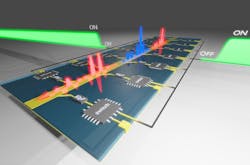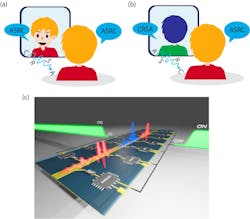Controlling light in time via tailored metamaterial?
For more than 60 years, physicists pondered the possibility of a different form of wave reflections: temporal or time reflections. Unlike spatial reflections, which occur when light or sound waves hit a boundary such as a mirror or a wall at a specific location in space, time reflections occur when the entire medium in which the wave is traveling suddenly and abruptly changes its properties across all of space. When this occurs, a portion of the wave is time reversed and its frequency gets converted to a new frequency.
Until now, this phenomenon hadn’t been observed for electromagnetic waves. Why? Optical properties of a material can’t be easily changed at a speed and magnitude that induces time reflections.
This is where metamaterials come in, and Andrea Alù’s team at the Advanced Science Research Center at the CUNY Graduate Center (CUNY ASRC) achieved a breakthrough experiment in which they observed time reflections of electromagnetic signals in a tailored metamaterial (see video).
“Time reflections were predicted theoretically decades ago, and recently there’s been a resurgence of interest because of the new opportunities stemming from controlling light in time,” says Andrea Alù, distinguished professor of physics at The City University of New York Graduate Center and founding director of the CUNY ASRC Photonics Initiative. “Yet, no experiment had demonstrated time reflections before. We came up with the solution to the challenges that prevented this observation in our metamaterial design.”
Alù is known for his amazingly mind-bending work with metamaterials to create technologies where light and sound—and now time—appear to disobey conventional rules.
“The challenge in demonstrating time reflection is due to the difficulty in creating a time interface,” Alù says. “A time interface requires very fast and substantial changes of the properties of the metamaterial in which light is traveling. We found a metamaterial geometry that allows us to load and unload very fast and uniformly reservoir capacitors, which enabled us to meet the conditions required to observe time reflections.”
A roadblock in previous studies preventing time reflections “was the belief that it would require large amounts of energy to create a temporal interface,” says Gengyu Xu, a postdoctoral researcher working with Alù at CUNY ASRC. “It’s very difficult to change the properties of a medium quick enough, uniformly, and with enough contrast to time reflect electromagnetic signals because they oscillate very fast. Our idea was to avoid changing the properties of the host material, and instead create a metamaterial in which additional elements can be abruptly added or subtracted through fast switches.”
Mind-bendy metamaterials
Using a fancy metamaterial design, the team changes the material’s properties in time—abruptly and with a large contrast.
This causes a significant portion of the broadband signals traveling in the metamaterial to be instantaneously time reversed and frequency converted, which results in a strange echo in which the last part of the signal is reflected first. Think of it as akin to looking into a time mirror: your reflection is flipped, and you’re seeing your back instead of your face. In an acoustic scenario, you’d hear sounds similar to the rewinding of a tape.
The team also showed the duration of time-reflected signals was stretched in time due to broadband frequency conversion. Think of it as: all the light signals visible to our eyes (colors) abruptly transform so red becomes green, orange turns blue, and yellow appears violet.
What are the researchers using for metamaterials? They inject broadband signals into a meandered strip of metal about 6 meters long, printed on a board, and loaded with a dense array of electronic switches connected to reservoir capacitors. Then, all switches are triggered at the same time—suddenly and uniformly doubling the impedance along the line. This quick and large change in electromagnetic properties produces a temporal interface, and the measured signals faithfully carry a time-reversed copy of the incoming signals.
Exotic electromagnetic properties of metamaterials are engineered by combining many spatial interfaces. “Our experiment shows that it is possible to add time interfaces into the mix— extending the degrees of freedom to manipulate waves,” says Shixiong Yin, a graduate student at CUNY ASRC and at The City College of New York. “We’ve also been able to create a time version of a resonant cavity, which can be used to achieve a new form of filtering technology for electromagnetic signals.”
Metamaterial platform can combine multiple time interfaces
The team’s metamaterial platform can combine multiple time interfaces, which enables electromagnetic time crystals and time metamaterials (see figure). Combined with tailored spatial interfaces, this discovery offers the potential to open new directions for photonic technologies—and new ways to enhance and manipulate wave-matter interactions.This work is groundbreaking because it shows it’s indeed possible to achieve a time interface, producing efficient time reversal and frequency transformation of broadband electromagnetic waves. Both these operations offer new degrees of freedom for extreme wave control. This achievement can pave the way for applications in wireless communications and the development of small, low-energy wave-based computers.
“It’s been impressive to observe significant time reversal of very broadband signals, which implies both ‘playing in reverse’ the incoming waves and translating their frequencies uniformly,” says Alù. “The signals are preserved in shape and stretched in time after the time interface.”
Another astounding aspect of their experiment is “the theory of time interfaces had to be rewritten because the boundary conditions involved, as we demonstrated, were not the ones theoretical papers had assumed since the start of this field of research,” he explains. “We were able to explain why the phase of our measured time reflected signals were flipped compared to what we expected because of the way we created time interfaces in our setup.”
Quantum realm?
The team’s time interfaces achieve very fast and efficient phase conjugation and time reversal across a very wide bandwidth. “This operation is of great interest both for signal processing and computing,” Alù says. “We’re also studying the effect of time interfaces in a quantum setting, for a few photons, and we believe it can have implications for quantum computing.”
In the context of defense research, “time interfaces can be of interest for efficient frequency transformations and for channel estimations in radar applications,” Alù adds.
What’s next? “We’re working on extending these phenomena to higher frequencies and for quantum applications,” says Alù.
FURTHER READING
H. Moussa et al., Nat. Phys. (2023); https://doi.org/10.1038/s41567-023-01975-y.
A. Alù, Scientific American (2022); https://bit.ly/400F6TR.
About the Author
Sally Cole Johnson
Editor in Chief
Sally Cole Johnson, Laser Focus World’s editor in chief, is a science and technology journalist who specializes in physics and semiconductors.


